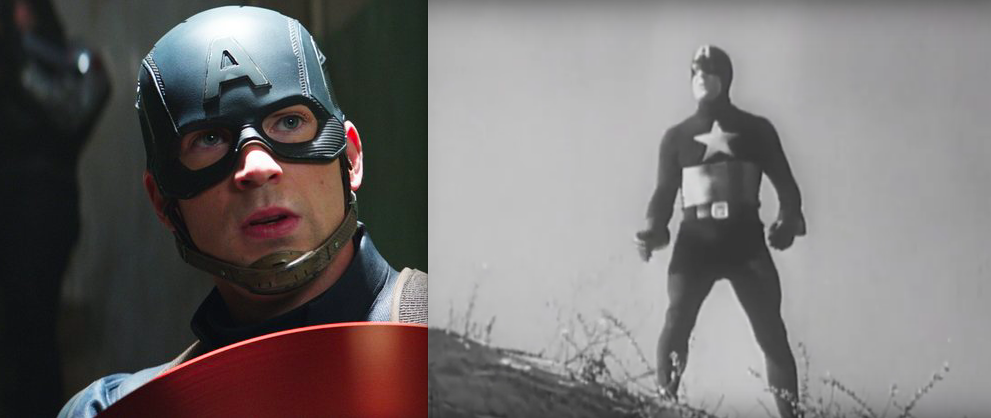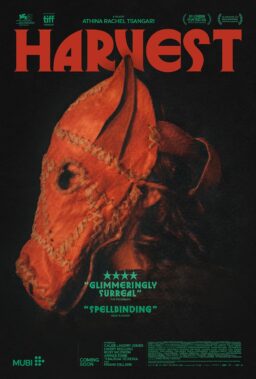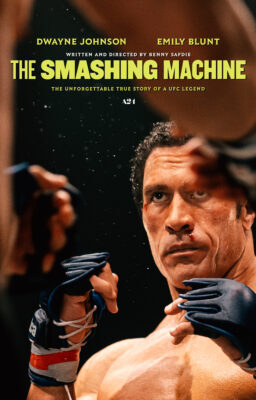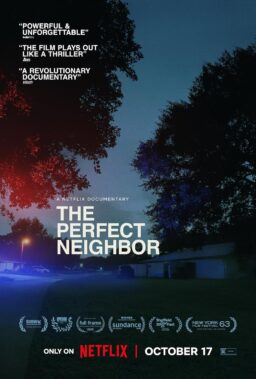The following is the second installment of what’s turning into an informal, um, serialized bunch of articles about serialized entertainment. It’s titled “What’s Next.” You can read the first part, about “Game of Thrones’ and “Avengers: Endgame” here.
The first time I remember seeing an actual cliffhanger-driven movie serial, the kind made during the heyday of the form, was back in the mid-’70s. I was maybe eight or nine years old. It was a chapter of the original black-and-white Captain America serials distributed by Republic Studios in the 1940s, the kind that was released to theaters one episode every Saturday. Every installment ran the length of two reels of 35mm film, approximately 24 minutes. I stumbled upon this particular installment while switching channels one Saturday morning, during the space between cruddy cartoons on the broadcast networks. I had no idea I’d stumbled into the middle of the tale. I only knew that it was mesmerizing, and Captain America was awesome.
A bad guy had rigged a remote-controlled truck with explosives for a nefarious purpose. Somehow Captain America rode his motorcycle to an interception point, jumped off a bluff onto the back of the truck, climbed into the cab. and took the wheel, at which point the bad guy steered the truck into the side of a house, blowing it sky-high.
Ker-BLAM!


Then the image faded to black over the roaring flames, and then a title card came up:
“Next Week: Chapter Five: BLADE OF WRATH.”

My jaw fell open. I couldn’t believe what I was seeing. The very idea of not finishing a story. Of just…stopping it. So suddenly and violently. And telling me to come back next week for more.
It broke my little brain.
Then mom took me and my younger brother to lunch at a local diner called Henry’s. I sat there in silence, staring at my grilled cheese sandwich and French fries. Mom asked me what was wrong. I told her about the thing I’d just watched and described how it ended.
“Well, what’s the problem, then?” she asked, trying not to let on how how amused she was.
“Well…” I said. “Is Captain America going to die?”
She paused for a moment, then said, “Well, seeing as how it’s called ‘Captain America,’ my guess would be no.”
One of the local TV stations in my hometown of Dallas, Texas, used to show these old serials every Saturday morning. They were aimed at kids, and were built around adventurers and do-gooders like Captain America, Hopalong Cassidy, Batman, Superman, and the Lone Ranger. These theatrical serials were popular before televisions became common household items. And they continued to be produced and distributed well into the first decade of TV’s popularity, the 1950s. But after that point, TV itself absorbed them, even creating their own homegrown, in-house versions of the same stuff that you used to have to go to theaters to see. For instance, Superman and Batman were once the subject of theatrical serials, and then they became the stars of TV shows (Superman in the 1950s, with George Reeves as the star, and Batman in the 1960s, starring Adam West).
I didn’t realize that this “new” thing I was seeing when I watched Captain America going up in smoke was actually something very old, and that it would become new again in my lifetime in ways none of us could have foreseen.
Nor did I understand that it had plenty of antecedents, in comic strips, radio drama, and in popular literature. Charles Dickens remains the most famous example; most of his best-known works were published in installments in magazines and newspapers. But Arthur Conan Doyle, Henry James, Herman Melville, and many other writers published that way too, in pieces.
I’d read comic books and comic strips that kept a story going over long periods. But I had no idea you could tell a story that way with moving pictures—broken into pieces and told in installments—because that’s not really how things were done at that point in time.
I’d grown up on movies that lasted anywhere from 90 minutes to three hours and told one story. If the movie was popular enough to merit a sequel—as was the case with the original “Jaws,” “Rocky” and “Star Wars,” all of which came out when I was in elementary school—you had to wait a long time to see it. Three years, at least. And the story didn’t necessarily pick up wherever the last one left off. I mean, sometimes it did. The “Rocky” movies always began with a flashback to the fight that ended the previous movie. But not always. The latest movie might refer to what had happened in the previous movie, fleetingly or at length, but the main story tended to stand on its own, because the studio wanted it to appeal to people who hadn’t seen the preceding installment, as well as to those who had.
TV shows were done that way, too. Once in a while, a TV series might do a cliffhanger finale, as part of a two- or three-parter, or as the final episode in a season, to hook people and make them want to “tune in” a few months later for the new season. But this sort of thing was rare. Self-contained stories were the default on TV as well as in cinema. They were the default because nobody had quite figured out a way to make the old “chapters” of a movie or TV series easily accessible, the way books, magazines, and newspapers had done with comic books, comic strips and serialized fiction, where you could save several successive issues and keep them by your easy chair or bedside table and re-read them and refresh your memory.
See, before home video, and the electronic storage of media, TV and movies used to be things that came and went, like live radio plays. Movies and TV episodes were tangible things, discrete and measurable, and in the case of movies, they were actual physical objects, 35mm prints that were shipped to theaters and then returned to the distributor when the buzz wore off and people quit buying tickets to see them.
Yet they were also ephemeral.
Blink, culturally speaking, and you missed them.
You saw movies when they were in theaters. If you didn’t catch them during their original runs—typically you had at least a few weeks to do this; maybe months or longer with hit films; not like today, where even the biggest blockbusters are gone after four weeks—you had to wait until they appeared in second-run (discount) movie houses, or showed up on TV. And you still had to be in a particular place at a particular time to able to experience them. The medium set the rules, not you. There was no streaming library, no on-demand cable, no DVR ro TiVo, no Blu-Rays, no DVDs, no VHS cassettes. You couldn’t store things on your phone. The very idea of a phone you could carry in your pocket was absurd. The phone was a thing that was plugged into a wall with a cord. All you could do with it was talk into it.
TV series weren’t serialized in the way that they are now—or in the way that certain movies/series, like the MCU entries, are today—because of the information retrieval problem, or refreshing-your-memory problem. Back in the pre-home-video era, unless you could watch every single episode of a TV series in succession, a TV show with a complicated plot and lots of characters was likely to alienate the audience. TV was a thing that you could follow without paying close attention to. That’s what it was for. A lot of TV producers who worked during that era have unselfconsciously described a lot of TV from that period to me as “radio with pictures,” to explain why characters were constantly announcing and summarizing things that you could already see that they were doing, and why an episode would return from a commercial break and have somebody summarize the last big thing that happened before the ads. The writers and directors and producers who created these stories weren’t taking chances that people might miss an important plot point just because they got up to go to the bathroom or make a sandwich or let the dogs out.
Until the 1970s, there weren’t a lot of heavily serialized TV shows in so-called prime time, the evenings. Daytime was filled with soap operas that ran five days a week, which was better for narrative retention, and even there, the writers made sure to have characters dump exposition every chance they got, even when the episode was airing on a Friday afternoon and they were referring to things that happened Thursday or Wednesday. The nighttime shows that were more friendly towards serialization, like “The Untouchables” and “The Fugitive,” also made sure to tell a self-contained story that had a beginning, middle and end, and that tied up most of the loose ends within the episode, so that casual viewers could come away feeling like they’d gotten at least a bit of closure.
The most successful exceptions were lavishly produced miniseries that announced themselves as serials and only ran for a certain number of episodes, which allowed people to plan to watch them, secure in the knowledge that their time commitment would not be open-ended, and that after a certain point, the story would wrap up and they could get on with their lives.
“Rich Man, Poor Man” was the first hit in this vein, but the biggest success by far was “Roots,” the adaptation of Alex Haley’s bestseller about the impact of slavery. ABC broadcast it over consecutive nights in January, 1977, traditionally a slow ratings month, because they worried that it was uncommercial (i.e., white people wouldn’t be interested in it) and wanted to get it off their schedule fast. To their shock, the audience was gigantic and racially diverse from the jump, and got bigger every night. By the end, “Roots” was the top-rated non-sports program in TV history. Over the next decade there would be many more productions in this mode, including “Roots: The Next Generation,” “The Winds of War” and its sequel “War and Remembrance,” “North and South,” “North and South: Book Two,” “Holocaust,” “Shogun,” and “Amerika.”
The most artistically adventurous and demanding weekly dramas of the ’80s and ’90s, like “Twin Peaks” and “Crime Story” and “Murder One,” had trouble attaining that level of success because they aired new episodes once a week, and as a result, they kept running into that narrative retention issue. Lots of households had VCRs, but it was a running joke among standup comics that very few people actually knew how to program them in order to record shows as they aired, instead using them to play prerecorded cassettes that they’d bought or rented. (More than one hack comic referred to the VCR as a $200 clock that blinks 12:00.)
Audiences wanted their shows to just get to the point—tell us who killed Laura Palmer; have Lt. Torello catch the gangster Ray Luca; etc—and they started to resent it whenever a show went on too long without wrapping up the central story, if it had one. Even creatively innovative series like “Oz,” “The Sopranos” and “Buffy the Vampire Slayer” blended long-form storytelling, with plot-lines that stretched out over a whole season, and stand-alone stories that resolved within the hour. There was still a popular resentment of TV shows that demanded one’s full attention over long periods of time. Short bursts of concentration was OK. Several consecutive years of watching shows that you could dip in and out of: that was OK, too. But anything beyond that was too much to ask. People didn’t want to commit to a series, miss one episode, and come back the following week and have trouble following the plot.
It wasn’t until the early 21st century, with the spread of TiVo, DVR and other easy-to-use, on-demand technology, that people got more comfortable with series that favored intricate, interlocking, long-form stories. But people still weren’t ready for them, not on a large scale, because the technological context wasn’t quite there yet, still. Even the good examples of heavily serialized TV, like “The Wire” and “The Shield” and “Mad Men” and “Battlestar Galactica,” tended to be critical successes more so than hugely popular ones. People talked about those shows, even pored over them like decodable texts. But what large numbers of people really wanted to watch week in and week out was stuff like “ER,” “The West Wing” and comedies like “Two-and-a-Half Men” and “Seinfeld” and “Friends” and “Everybody Loves Raymond,” which favored stand-alone narratives that wrapped up neatly at the end of the episode. When a TV show managed to be both intricately serialized and popular, as both “Lost” and “24” were, the competition stampeded to copy them. They nearly always failed, because the copies lacked whatever precious alchemy powered the originals. Only “Lost” could be “Lost,” and “24” without Jack Bauer was just discount James Bond (unless it was called “Alias,” but even that show was more about discrete, self-contained missions than long-form, tightly woven narratives that took months to play out).
The internet, which started to be hospitable to laypeople in the late 90s and early aughts, was another factor in making serialized narratives more accessible to the casual TV viewer. Fan-driven sites like Television without Pity worked in conjunction with digital video recording devices to continually refresh fans’ memories about what happened earlier. The interactive nature of the web let people go into chat rooms and ask specific, often very granular questions, about who was related to whom, whether that mysterious death from four seasons ago was ever solved, whether there was really money hidden in Livia’s house on “The Sopranos,” how many times a character wore a particular dress, and so on. This all edged serialized TV into something that felt a bit closer to a “perpetual present,” an experiential bubble in which old and new episodes were all happening now, because people were talking about them together.
Today, in the age of social media and streaming technology, every series ends up as part of a digital library, where it can be accessed as easily as stacks of newspapers containing the last two weeks’ of “Mary Worth” or “Dick Tracy,” or copies of magazines containing the last few chapters of whatever Dickens or Doyle or Melville was up to. Or piles of comic books next to a child’s bed, which is where we’re eventually going with this series of articles (it’s also where we started, if you’re experiencing this as part two in a series). You can catch up with a serialized drama like “Game of Thrones” or “The Walking Dead” or “This is Us” or “Billions” in a matter of days or weeks via binge-watching, a process that’s much easier now that you only have to log onto Amazon or iTunes or shuttle though menus on Netflix or Hulu, instead of buying or renting boxes upon boxes of discs or cassettes, or hoping that your local cable provider has back-seasons of the show you’re interested in.
What’s next is what’s happening now. It’s driving everything. And it’s easier than it’s ever been to get caught up fast, to get to the point where you can look ahead to what’s next.

The escalation of pace on the theatrical side has been incremental but striking. Starting in 2000, the Harry Potter franchise put out eight films in ten years, a staggering pace for such long, expensive, complexly plotted motion pictures. The original “Lord of the Rings” films put out three films in three years, a total of almost ten hours of entertainment (more than twelve if you bought the expanded DVDs). Both franchises owe a lot to television (the length works out to about three new episodes per year of a dramatic TV series, a format where chapters usually run between 42 and 60 minutes). But they also owe a lot to sheer chutzpah, in the vein of super-producers of 20th century cinema like Cecil B. DeMille and David O. Selznick.
None of the filmmakers or studio executives involved with the Harry Potter movies knew for sure that they could keep the thing going as long as they managed to without losing audience interest, or losing one of the main cast members to puberty or mortality (they did suffer one major death, and recast the part without much fuss). And there was no crystal ball at New Line Cinema, which rolled the dice on a trilogy of three-plus-hour Tolkien films budgeted at a total of $300 million. The studios all just hoped, or figured, that it would work. And it did. And success led to another escalation, of both pace and scale.
The dopamine rush of what’s next really starts to come into its own cinematically around the late aughts, which not coincidentally is when Christopher Nolan’s “Dark Knight” trilogy (which released three installments over seven years) was supplanted by the next iteration of blockbuster fantasy cinema, the first in the 22-film Marvel Comics Universe series.
The first entry in that franchise, the original “Iron Man,” arrived on screens the same year as the second Nolan Batman film—2008—and released new movies with increasing frequency, all the way to 2019, which climaxed with the juggernaut “Endgame.” Fifteen months after the success of “Iron Man,” Marvel Studios became a wholly owned subsidiary of Disney, which harbored plans as grand as any comic book villain’s, and knew a relentless and proficient entertainment machine when they saw it.
Over the next ten years, Marvel Studios got really good at this kind of entertainment, and refined its production processes to the point where the films all felt like products of the same well-oiled assembly line. The films tended to be humorous and exciting if rarely great or challenging. Familiarity was their greatest weapon. You could nearly always expect to see certain elements when you bought a ticket (like the revelation of a turncoat in the heroes’ midst, and a climactic battle raging over a solid half-hour in a variety of locations, filled with huge things crashing into other huge things) even when they permitted directors with strong aesthetic personalities, such as Ryan Coogler and Taika Waititi, to imprint their sensibilities on the products.
Rival studios that tried to do their own version of the MCU films stumbled, either because they entrusted the franchise to directors with stronger but more divisive personalities than ones favored by Disney (like Nolan and Zack Synder, who controlled the Warner Bros.-owned DC Comics Expanded Universe films, and preferred the films to be bleak, dark, macho, and brutal) or because the studios didn’t really have any vision to speak of beyond, “We want our own version of the MCU, somebody get on that.”
This appears to have been the fate of the DCEU, which frustrated fans by whipsawing between serialized and non-serialized architecture, and between grim epics like “Batman vs. Superman” and light, even goofy ones like “Aquaman,” but still hasn’t gotten the hang of sustaining intricate, ongoing stories over long periods of time. Universal didn’t even get as far as mixed messages: it tried to tie all its classic movie monsters together in a single universe, then aborted the project after the Tom Cruise vehicle “The Mummy” bombed. Sony Pictures had better luck with its kaiju movies (starting with 2013’s “Godzilla”), and even tied the Toho monsters and King Kong together through something called “The Monarch Initiative” (shades of the MCU’s Avengers Initiative, complete with post-credits “stingers” teasing what’s next). But it has yet to ramp up production to the point where it can make more than one feature every few years, and as a result, it doesn’t feel the way the MCU movies ultimately started to feel: like a public utility or a patriotic obligation, a thing you had to take part in every three months or risk feeling left out of The Conversation.
The new Star Wars films, which are also owned by Disney now, have a more mixed track record than the MCU franchise entries. They’ve all made gigantic amounts of money—even “The Last Jedi,” the most divisive SW film since “The Phantom Menace,” was exactly on track with the other two trilogies, delivering box office that dropped off about the same percentage as the other middle installments, “The Empire Strikes Back” and “Attack of the Clones” (and for that matter, “The Matrix Revolutions,” the middle part of what’s basically R-rated Star Wars). But the costs were so immense that the studio has scaled back a bit on its plans to flood the market with one-off “Star Wars Stories” features, in the vein of “Rogue One” and “Solo.” The future of that franchise—and perhaps the MCU as well, who can say—might lie on Disney+, the as-yet-un-launched streaming service that’s supposed to strike the fear of God and Uncle Walt into Netflix.

As you read this, “Endgame” is on track to become the top-grossing movie of all time—eclipsing James Cameron’s “Avatar,” itself now the projected first entry in a series of at least four movies, all long-delayed—and the big questions after that will be whether Disney and Marvel can equal that success.
It’s not impossible to imagine, but it does strike me as unlikely, because the MCU franchise hasn’t just made unimaginable amounts of money at worldwide box-offices: it has spent the last decade retraining, even rewiring, audience’s brains.
Viewers now expect big-budget fantasy entertainment to be thrillingly, tantalizingly serialized, to deliver new installments close together enough that the last movie will be fresh in people’s minds via social media, and might even still be playing in a local theater (as was the case with Marvel chapter 21, “Captain Marvel,” the second top-grosser the weekend that “Endgame” opened). Loyal MCU viewers who are in high school or college now were brought to theaters with their parents to see the early installments in the franchise. Many of them have a Pavlovian association between movie theaters and, not movies generally—in the sense of self-contained stories with beginning, middles, and ends—but segments of a larger narrative, a hybrid of the television series or miniseries and the expensive big-screen sound-and-light show.
This is not an unprecedented change—my generation, the Gen-Xers who came of age in the ’70s and ’80s, saw theatrical film series such as the original “Star Wars,” “Back to the Future,” “A Nightmare on Elm Street,” “Lethal Weapon” and so forth as “normal,” whereas our parents might’ve grumbled that these endless sequels reminded them too much of television, an ironic complaint considering that they grew up on 1940s and 50s theatrical serials like the Captain America series that so disturbed me when I stumbled across it as a child. Some of those film series, notably the first batch of “Star Trek” films and the Tom Cruise “Mission: Impossible” franchise, actually did come from television.
But the omnipresence and undeniable success of the MCU does feel like an escalation, or a fine-tuning, of a certain mode of telling stories. It’s one that turns movie theaters into open-air content delivery venues, not unlike the phone or laptop that you’re using to read this piece, and that you’ll eventually resume treating as a slot machine, continually refreshing Facebook or Twitter or Instagram to see if there are any new likes or comments.
The big question now is whether, once the cultural smoke clears and we get a glimpse of the future, movie theaters will still seem like temples of popular storytelling, places where people can experience a wide array of stories told at different scales; or if we’ll associate them mainly with places to see the latest edition of whatever superhero or space fantasy or monster series happens to be capturing the imagination. The bigfoots, the kaiju, of popular culture.
Will cinema, as we’ve known it for roughly the last 60 years, survive?
Come back next week, or whenever I get the next one of these finished, and we’ll try to figure out what’s next.












